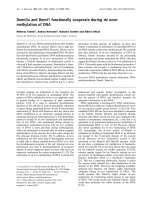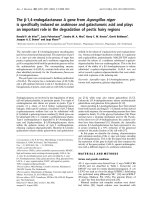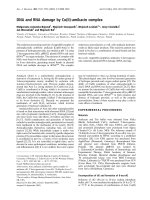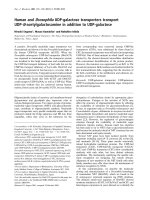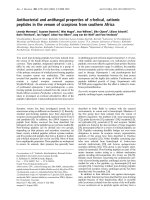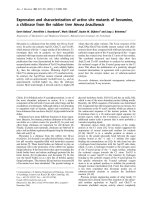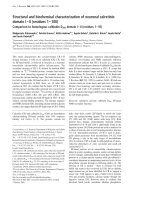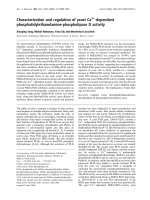Báo cáo y học: " TRIM5α and TRIMCyp form apparent hexamers and their multimeric state is not affected by exposure to restriction-sensitive viruses or by treatment with pharmacological inhibitors" doc
Bạn đang xem bản rút gọn của tài liệu. Xem và tải ngay bản đầy đủ của tài liệu tại đây (1.34 MB, 7 trang )
BioMed Central
Page 1 of 7
(page number not for citation purposes)
Retrovirology
Open Access
Short report
TRIM5α and TRIMCyp form apparent hexamers and their
multimeric state is not affected by exposure to restriction-sensitive
viruses or by treatment with pharmacological inhibitors
Marie-Édith Nepveu-Traversy, Julie Bérubé and Lionel Berthoux*
Address: Laboratory of retrovirology, University of Québec, Trois-Rivières, QC, G9A 5H7, Canada
Email: Marie-Édith Nepveu-Traversy - ; Julie Bérubé - ; Lionel Berthoux* -
* Corresponding author
Abstract
Proteins of the TRIM5 family, such as TRIM5α and the related TRIMCyp, are cytoplasmic factors
that can inhibit incoming retroviruses. This type of restriction requires a direct interaction between
TRIM5 proteins and capsid proteins that are part of mature, intact retroviral cores. In such cores,
capsids are arranged as hexameric units. Multiple lines of evidence imply that TRIM5 proteins
themselves interact with retroviral cores as multimers. Accordingly, stabilization by crosslinking
agents has revealed that TRIM5α and TRIMCyp are present as trimers in mammalian cells. We
report here that TRIM5 proteins seem to form dimers, trimers, hexamers and multimers of higher
complexity in mammalian cells. The hexameric form in particular seems to be the most abundant
multimer. Multimerization did not involve disulfide bridges and was not affected by infection with
restriction-sensitive viruses or by treatment with the known TRIM5 inhibitors arsenic trioxide,
MG132 and cyclosporine A. We conclude that TRIM5 multimerization results from more than one
protein-protein interface and that it is seemingly not triggered by contact with retroviral cores.
Findings
TRIM proteins form a family with dozens of members,
most of them bearing a tripartite motif composed of a
RING, B-box and Coiled-coil domains [1]. Restriction of
retroviruses by members of the TRIM5 subfamily of TRIM
proteins, which comprises the primate proteins TRIM5α
and TRIMCyp [2-4], is initiated by physical recognition of
the incoming retrovirus by TRIM5 proteins. This interac-
tion occurs within the first hours following virus entry [5]
and involves determinants present in the N-terminal
domain of the capsid proteins which constitute the retro-
viral outer core structure [6-8]. Retroviral capsid cores are
assembled from hundreds of capsid proteins and the basic
capsomer is a hexamer [9-11]. Restriction necessitates cap-
sid proteins of the incoming retrovirus to be correctly mat-
urated by the retroviral protease [12,13]. This is a required
step for the core to adopt its final structure. In addition,
mutations that affect the stability of the retroviral core
interfere with the efficiency of restriction [12,13]. Virus-
free capsid proteins, which do not multimerize to form
cores, do not interact with TRIM5 proteins in cells [14].
That TRIM5-mediated restriction requires assembled ret-
roviral cores brings the question of whether TRIM5 pro-
teins themselves must be present as multimers. TRIM
proteins are known to homomultimerize through their
coiled-coil domain [1], which is required for restriction
[15]. TRIM5 proteins from different species can interact
with each other and in doing so can interfere with each
other's restriction activity [16]. TRIM5α has also been
shown to trap incoming retroviral particles inside cyto-
Published: 3 November 2009
Retrovirology 2009, 6:100 doi:10.1186/1742-4690-6-100
Received: 27 August 2009
Accepted: 3 November 2009
This article is available from: />© 2009 Nepveu-Traversy et al; licensee BioMed Central Ltd.
This is an Open Access article distributed under the terms of the Creative Commons Attribution License ( />),
which permits unrestricted use, distribution, and reproduction in any medium, provided the original work is properly cited.
Retrovirology 2009, 6:100 />Page 2 of 7
(page number not for citation purposes)
plasmic bodies, which further suggests that TRIM5 pro-
teins interact with their targets as multimers [17]. TRIM5α
and TRIMCyp have been stabilized as trimers by treatment
with cross-linking agents [18-23]. Some undefined
higher-order multimers have been occasionally observed
[18,19]. The relevance of trimerization was confirmed by
the fact that modified TRIMCyp, in which the coiled-coil
domain is substituted by that of a trimeric heterologous
protein, restricted HIV-1, although at much lower levels
than wild-type TRIMCyp did [19]. A recombinant TRIM5
protein expressed in insect cells was observed as dimers
[21] and minor amounts of dimeric TRIM5α have been
observed in cells [23]. However, dimerization/trimeriza-
tion of TRIM5 proteins fails to explain the formation of
cytoplasmic bodies or the sequestration of incoming
restricted virus in such structures. Thus, we analyzed
TRIM5α/TRIMCyp multimerization in the presence or
absence of restriction-sensitive viruses and upon treat-
ment with various drugs that inhibit the restriction proc-
ess.
We first analyzed TRIM5 multimerization in stably trans-
duced Mus dunni tail fibroblast (MDTF) cell lines [24].
Multimers were stabilized by treatment with glutaralde-
hyde as first described by Mische and collaborators [23].
Surprisingly, TRIM5α
rh
was not present as a trimer in these
cells. Rather, we observed a band with a size in the 300-
400 kDa range (Fig. 1), and subsequent experiments that
used a different molecular weight marker confirmed this
apparent weight. Since the TRIM5α
rh
monomer migrates
at 55 to 60 kDa, this multimer may be a hexamer. Higher-
order multimers were also seen but their size could not be
estimated. These high molecular weight multimers were
present in the stacking gel when they were seen; and in
some experiments they were found to have barely pene-
trated the acrylamide. We cannot exclude that they might
be aggregates rather than genuine higher-order assemblies
of TRIM5α. TRIMCyp was found in MDTF cells as dimers
and trimers and also as higher-order multimers that
included a band slightly heavier than the 250 kDa marker
(Fig. 1). Since monomeric TRIMCyp migrates at about 45
kDa, the multimer seen is most likely a hexamer
(although the migration pattern of multimeric complexes
might be different from those of linear proteins). Higher
amounts of glutaraldehyde were required to reveal the
presence of hexamers and higher-order multimers, com-
pared with dimers or trimers. Thus, TRIM5α and TRIM-
Cyp can have distinct multimerization profiles despite
both being fully active in MDTF cells. They also share the
capacity to form apparent hexamers. Because coiled-coil
domains can dimerize through the formation of covalent
disulfide bridges between cysteine residues in some
instances [25], we performed a Western blot analysis of
TRIM5α and TRIMCyp in reducing and nonreducing con-
ditions. In the absence of β-mercaptoethanol, both
TRIM5α and TRIMCyp were less easily detected, but
migrated at the expected size; and no dimer or more com-
plex multimers were visible (Fig. 1B), with the exception
of very high molecular weight structures which seemed to
be present in higher amounts compared to the reducing
conditions. Thus, it appears that disulfide bridges do not
induce TRIM5 protein dimers, trimers or hexamers, but
perhaps they are involved in the formation of non-specific
aggregates.
To investigate the possibility that TRIMCyp multimeriza-
tion was induced or modulated by exposure to a restric-
tion-sensitive virus, we repeated the glutaraldehyde
crosslinking assay after 6 hours of continuous infection
with TRIP-CMV-GFP, which is an HIV-1 vector encoding
GFP [24,26]. Approximately 1% of the MDTF-TRIMCyp
cells were infected in these conditions, versus more than
50% of the same cells not expressing TRIMCyp (not
shown). Thus, TRIMCyp restriction activity was not satu-
rated at this multiplicity of infection (MOI), yet cells were
exposed to large amounts of HIV-1 virions in order to
maximize the frequency of TRIMCyp:capsid interaction.
However, HIV-1 infection did not noticeably modify the
relative amounts of TRIMCyp trimers, hexamers and
higher-order multimers (Fig. 2A). We repeated the experi-
ment in the presence of cyclosporine A (CsA), which com-
pletely abrogates the restriction mediated by TRIMCyp as
it binds to the same CypA domain that recognizes HIV-1
capsid proteins [27,28]. CsA treatment, however, had no
effect on TRIMCyp multimerization profiles, further
implying that multimerization was independent of spe-
cific virus recognition.
It was recently reported that TRIM5α and TRIMCyp are
degraded in a proteasome-dependent pathway following
infection with a restriction-sensitive retrovirus [29]. Thus,
it was conceivable that in our previous experiment HIV-1
modulated the multimerization of only a part of the cel-
lular TRIMCyp proteins which were then degraded by the
proteasome. To address that possibility, we repeated the
experiment in the presence of the proteasomal inhibitor
MG132, thereby preventing virus-induced TRIMCyp tar-
geting to the proteasome (not shown). In addition we
infected with a higher dose of the HIV-1 vector, leading to
20% infected cells. TRIMCyp restriction activity was sig-
nificantly saturated at this MOI, implying that most TRIM-
Cyp proteins that were restriction-competent at the time
of infection were indeed engaging incoming HIV-1 [24].
However, MG132 did not appreciably modify the mul-
timerization profile of TRIMCyp in the absence or pres-
ence of HIV-1 (Fig. 2B). Like before, dimers, trimers and
higher-order multimers were formed. The band corre-
sponding to putative hexamers was less well-defined com-
pared with previous experiments, but this is probably due
Retrovirology 2009, 6:100 />Page 3 of 7
(page number not for citation purposes)
to technical reasons unrelated to the effects of MG132 on
TRIM5.
We used MDTF cells expressing TRIM5α cloned from Vero
cells (African green monkey) [24] to investigate whether,
unlike that of TRIMCyp, TRIM5α multimerization could
be modulated upon infection with a restricted virus. This
orthologue of TRIM5α decreases HIV-1 replication by
about 100-fold [30] and also inhibits the N-tropic strains
of the murine leukemia virus (MLV), although to a
smaller extent (10-fold or less) [24]. As in Fig. 2, we chal-
lenged these cells with restricted (HIV-1 and N-MLV) or
non-restricted (B-MLV) viruses at relatively high doses
and in presence of MG132 (Fig. 3). Under these condi-
tions, the inhibition of N-MLV by TRIM5α
AGM
was lower
than previously observed, a likely consequence of the
MG132 treatment and of the high MOI (not shown).
TRIM5α
AGM
formed apparent trimers and hexamers in
these cells but no dimers were observed (Fig. 3A), nor did
we see multimers of very high molecular weight in this
particular experiment. Challenges with the different
viruses had little effect on the multimerization pattern.
The relative number of hexamers stabilized at the highest
glutaraldehyde concentration used, decreased slightly in
cells infected with one of the restricted viruses (HIV-1; Fig.
3A), but increased slightly in cells infected with the other
restricted virus (N-MLV; Fig. 3B). No notable differences
were found at the other glutaraldehyde concentrations.
Data from Fig. 2 and 3 together suggest that the multimer-
ization of TRIM5 proteins is not modulated by retroviral
infections. A caveat in these experiments, however, is that
the percentage of TRIM5 proteins actually engaged in the
restriction process at any given time is not known. Even at
high multiplicities of infection, it is still possible that
modulation of multimerization occurs at levels undetect-
able in our assays.
Arsenic trioxide (As
2
O
3
) inhibits the restriction activity of
TRIM5 proteins in a virus-independent, TRIM5 ortho-
logue-independent, cell type-dependent manner [30,31].
The mechanism of action of this drug on TRIM5 proteins
is at present unknown. Thus, it was of interest to analyze
whether it could affect the capacity of TRIM5 proteins to
multimerize. We found that As
2
O
3
did not affect TRIM5-
mediated restriction in MDTF cells (not shown), and thus
we used human HeLa cells for this particular experiment.
As expected, stable expression of TRIM5α
rh
and of TRIM-
Cyp in HeLa cells resulted in an approximately 100-fold
reduction in permissiveness to transduction with an HIV-
1 virus expressing GFP (not shown). We found that both
restriction activities were partly suppressed by As
2
O
3
treat-
ment (Fig. 4A). More precisely, a short (10 hours) treat-
ment with As
2
O
3
at the time of infection increased
permissiveness to HIV-1 by up to 15-fold in cells express-
ing TRIM5α
rh
and 20-fold in cells expressing TRIMCyp,
Multimerization profiles of TRIM5α and TRIMCypFigure 1
Multimerization profiles of TRIM5α and TRIMCyp. A,
0.5% NP40 lysates were prepared from Mus dunni tail fibrob-
last cells (MDTFs) stably expressing FLAG-tagged TRIM5α
rh
or owl monkey TRIMCyp. The soluble fraction of each lysate
was divided in aliquots that were treated for 5 min with the
indicated glutaraldehyde concentrations before proteins
were denatured by boiling in the presence of SDS. Proteins
were then separated on an 8% polyacrylamide gel, trans-
ferred to a nitrocellulose membrane, and probed with a rab-
bit anti-FLAG antibody (Cell Signaling). The apparent
multimeric states are indicated on the right as deduced from
the size of the bands. The star indicates an unspecific protein
cross-detected by the FLAG antibody. B, Lysates were pre-
pared from HeLa cells stably transduced with the same con-
structs as above and in the absence or presence of 100 μM
β-mercaptoethanol as indicated.
C
-
T
5
Į
r
h
T
C
y
p
C
-
T
5
Į
r
h
T
C
y
p
175
80
58
46
no ȕ-mE with ȕ-mE
Glutaraldehyde
(mM)
0
0
,
2
5
0
,
5
1
,
2
5
2
,
5
MW
(kDa)
50
75
250
150
monomer
trimer
hexamer?
0
0
,
2
5
0
,
5
1
,
2
5
2
,
5
MW
(kDa)
50
75
250
150
Glutaraldehyde
(mM)
monomer
hexamer?
*
*
HMW multimers
HMW multimers
TRIM5α
αα
α
TRIMCyp
dimer
A
B
Retrovirology 2009, 6:100 />Page 4 of 7
(page number not for citation purposes)
while having a smaller, "background" effect of about 4-
fold in the control untransduced cells. Crosslinking assays
yielded slightly different results in HeLa cells compared
with what had been observed in MDTF cells. TRIM5α
rh
did not dimerize but trimers were visible, as well as appar-
ent hexamers and higher-order multimers (Fig. 4B, upper
panel). TRIMCyp was found as dimers, trimers, and hex-
amers (Fig. 4B, lower panel). An additional band migrat-
ing faster than the hexamer was visible and could be a
pentamer. In both cases, the experiment was done in the
absence or presence of As
2
O
3
; and no differences were
observed. Therefore, arsenic trioxide does not influence
the multimeric state of TRIM5α and TRIMCyp.
We find that in addition to the dimeric and trimeric forms
previously described, TRIM5α and TRIMCyp can form
apparent hexamers and more complex multimers. Why
discrete hexamers were not previously seen by others is
probably only related to the difficulty of resolving high
molecular weight complexes in acrylamide gels, although
we cannot totally exclude that the C-terminus FLAG tag
used in our constructs may somehow interfere with pro-
tein multimerization. Because of low expression levels in
mammalian cells, it is not possible at this point to per-
form the biochemical experiments that would be needed
to ascertain that the various multimers seen here are com-
posed of TRIM5 proteins only. For instance, a trimer of
TRIM5 could associate with a heterologous cellular pro-
tein, yielding a band resembling a TRIM5 hexamer. Thus,
other approaches will be needed. The hexamer model is
obviously appealing because capsid proteins are them-
selves organized as hexamers in mature retroviral cores.
Thus, a hexamer of TRIM5 proteins could be needed to
recognize a retroviral capsomer. Formation of dimers,
trimers and hexamers, however, does not seem to be trig-
gered by contact with a restricted retrovirus. It remains
Multimerization of TRIMCyp in cells infected by HIV-1Figure 2
Multimerization of TRIMCyp in cells infected by HIV-1. A, MDTF-TRIMCyp cells were challenged with an HIV-1 vector
expressing GFP, at a dose leading to infection of about 1% of the cells and either in the presence or not in the presence of 5
μM cyclosporine A (Sigma). After 6 hours of infection, cells were lysed in presence of increasing glutaraldehyde concentrations
as in Fig. 1. Western blot analysis of FLAG-tagged proteins was performed as above. B, the experiment was repeated in the
presence of 1 μM MG132 (Sigma) and using two different virus doses. The stars indicate cellular proteins cross-detected by the
FLAG antibody as evidenced by analysis of lysates from parental cells (not shown).
50
250
150
75
No virus HIV-1 + CsA
Glutaraldehyde
HMW multimers
monomer
trimer
hexamer?
HIV-1 (MOI 0.01)
-
41
55
71
117
171
460
238
*
*
No virus
+ MG132
HIV-1 (MOI 0.2)
+ MG132
HIV-1 (MOI 0.01)
+ MG132
- - -
Glutaraldehyde
monomer
hexamer?
+ HMW
trimer
dimer
A
B
*
Retrovirology 2009, 6:100 />Page 5 of 7
(page number not for citation purposes)
possible that the nature and number of some specific
higher order multimers not resolved in our gels could be
modulated during the restriction process. Not surpris-
ingly, the coiled-coil domain of TRIM5 proteins has been
found to be required for the formation of trimers [18,23].
However, this does not imply that a single protein:protein
interface present in this domain is responsible for the var-
ious multimeric forms observed. Rather, it is more likely
that one interface would lead to dimerization and another
one to trimerization; together they would be responsible
for hexamerization. Perhaps yet other determinants
within TRIM5α and TRIMCyp lead to the formation of
very high molecular weight multimers. Consistent with
the existence of more than one molecular site of
TRIM5:TRIM5 interactions, Li and Sodroski have recently
reported that point mutants in the B-Box domain show
normal multimerization patterns in crosslinking assays
while being less efficient at engaging in protein:protein
interactions through co-immunoprecipitation assays [22].
Regardless of what the exact molecular mechanism of
TRIM5 multimerization is, our data suggest that TRIM5
multimerization is complex but that formation of low
molecular weight multimers is not influenced by contact
with a restricted retrovirus.
Multimerization of TRIM5α
AGM
is not modulated by infection with restriction-sensitive virusesFigure 3
Multimerization of TRIM5α
AGM
is not modulated by infection with restriction-sensitive viruses. A, MDTF cells
expressing TRIM5α
AGM
were either infected or not infected with HIV-1 for 6 hours, using a virus dose leading to about 15%
infected cells and in the presence of 1 μM MG132. Crosslinking assays were done as before. B, MDTF-TRIM5α
AGM
cells were
infected with identical amounts (as normalized by titration on parental cells) of B-MLV or N-MLV-derived vectors expressing
GFP in the presence of MG132. 30% and 10% of the cells were infected (GFP-positive), respectively, by B-MLV-GFP and N-
MLV-GFP, as seen by flow cytometry 2 days later.
117
238
171
No virus
+ MG132
Glutaraldehyde
monomer
trimer
hexamer?
HIV-1 (MOI 0.15)
+ MG132
55
71
117
171
460
238
N-MLV (MOI 0.1)
+ MG132
B-MLV (MOI 0.3)
+ MG132
-
-
Glutaraldehyde
monomer
hexamer?
trimer
A
B
55
71
*
*
460
- -
*
*
Retrovirology 2009, 6:100 />Page 6 of 7
(page number not for citation purposes)
As
2
O
3
does not modify the multimerization of TRIM5α and TRIMCypFigure 4
As
2
O
3
does not modify the multimerization of TRIM5α and TRIMCyp. A, human HeLa cells stably expressing
TRIM5α
rh
and TRIMCyp, or control untransduced cells, were challenged with an HIV-1 vector expressing GFP at virus doses
leading to about 1% infected (GFP-positive) cells in the absence of drug. Infections were performed in the presence of increas-
ing As
2
O
3
concentration (x-axis) and for 10 hours, after which supernatants were replaced with fresh medium to avoid As
2
O
3
-
related toxic effects. 2 days after infection, the % of cells expressing GFP were determined by flow cytometry analysis. Results
were expressed as -fold increase compared with the untreated control. The averages from triplicate infections with standard
deviations are shown. B, glutaraldehyde assays were performed exactly as before and in the absence or presence of 10 μM
As
2
O
3
.
0
5
10
15
20
25
0 5 10 15
Ctl
TRIM 5a(rh)
TRIMCyp
+ As
2
O
3
-As
2
O
3
50
100
75
250
150
-As
2
O
3
+As
2
O
3
- -
- -
MW
(kDa)
MW
(kDa)
50
100
75
250
150
*
37
*
-fold increase
As
2
O
3
(PM)
Glutaraldehyde
monomer
tr imer
hexamer?
HMW multimers
Glutaraldehyde
tr imer
monomer
hexamer?
HMW multimers
dimer
TRIM5 (rh)
TRIMCyp
A
B
Publish with Bio Med Central and every
scientist can read your work free of charge
"BioMed Central will be the most significant development for
disseminating the results of biomedical research in our lifetime."
Sir Paul Nurse, Cancer Research UK
Your research papers will be:
available free of charge to the entire biomedical community
peer reviewed and published immediately upon acceptance
cited in PubMed and archived on PubMed Central
yours — you keep the copyright
Submit your manuscript here:
/>BioMedcentral
Retrovirology 2009, 6:100 />Page 7 of 7
(page number not for citation purposes)
Competing interests
The authors declare that they have no competing interests.
Authors' contributions
MÉNT, JB and LB designed the study. MÉNT and JB per-
formed the experiments. LB drafted the manuscript. All
authors read and approved the final draft.
Acknowledgements
We thank Mélodie B. Plourde for help with drafting the manuscript. This
work was supported by the Canadian Institutes for Health Research and by
the Canada Research Chairs program.
References
1. Reymond A, Meroni G, Fantozzi A, Merla G, Cairo S, Luzi L, Riganelli
D, Zanaria E, Messali S, Cainarca S, et al.: The tripartite motif fam-
ily identifies cell compartments. Embo J 2001, 20:2140-2151.
2. Luban J: Cyclophilin A, TRIM5, and resistance to human
immunodeficiency virus type 1 infection. J Virol 2007,
81:1054-1061.
3. Nisole S, Stoye JP, Saib A: TRIM family proteins: retroviral
restriction and antiviral defence. Nat Rev Microbiol 2005,
3:799-808.
4. Towers GJ: The control of viral infection by tripartite motif
proteins and cyclophilin A. Retrovirology 2007, 4:40.
5. Perez-Caballero D, Hatziioannou T, Zhang F, Cowan S, Bieniasz PD:
Restriction of human immunodeficiency virus type 1 by
TRIM-CypA occurs with rapid kinetics and independently of
cytoplasmic bodies, ubiquitin, and proteasome activity. J Virol
2005, 79:15567-15572.
6. Hatziioannou T, Cowan S, Von Schwedler UK, Sundquist WI, Bieniasz
PD: Species-specific tropism determinants in the human
immunodeficiency virus type 1 capsid. J Virol 2004,
78:6005-6012.
7. Ikeda Y, Ylinen LM, Kahar-Bador M, Towers GJ: Influence of gag on
human immunodeficiency virus type 1 species-specific tro-
pism. J Virol 2004, 78:11816-11822.
8. Owens CM, Song B, Perron MJ, Yang PC, Stremlau M, Sodroski J:
Binding and susceptibility to postentry restriction factors in
monkey cells are specified by distinct regions of the human
immunodeficiency virus type 1 capsid. J Virol 2004,
78:5423-5437.
9. Li S, Hill CP, Sundquist WI, Finch JT: Image reconstructions of
helical assemblies of the HIV-1 CA protein. Nature 2000,
407:409-413.
10. Mortuza GB, Haire LF, Stevens A, Smerdon SJ, Stoye JP, Taylor IA:
High-resolution structure of a retroviral capsid hexameric
amino-terminal domain. Nature 2004, 431:481-485.
11. Pornillos O, Ganser-Pornillos BK, Kelly BN, Hua Y, Whitby FG, Stout
CD, Sundquist WI, Hill CP, Yeager M: X-ray structures of the
hexameric building block of the HIV capsid.
Cell 2009,
137:1282-1292.
12. Forshey BM, Shi J, Aiken C: Structural requirements for recog-
nition of the human immunodeficiency virus type 1 core dur-
ing host restriction in owl monkey cells. J Virol 2005,
79:869-875.
13. Shi J, Aiken C: Saturation of TRIM5 alpha-mediated restriction
of HIV-1 infection depends on the stability of the incoming
viral capsid. Virology 2006, 350:493-500.
14. Sebastian S, Luban J: TRIM5alpha selectively binds a restriction-
sensitive retroviral capsid. Retrovirology 2005, 2:40.
15. Perez-Caballero D, Hatziioannou T, Yang A, Cowan S, Bieniasz PD:
Human tripartite motif 5alpha domains responsible for ret-
rovirus restriction activity and specificity. J Virol 2005,
79:8969-8978.
16. Berthoux L, Sebastian S, Sayah DM, Luban J: Disruption of human
TRIM5alpha antiviral activity by nonhuman primate ortho-
logues. J Virol 2005, 79:7883-7888.
17. Campbell EM, Perez O, Anderson JL, Hope TJ: Visualization of a
proteasome-independent intermediate during restriction of
HIV-1 by rhesus TRIM5alpha. J Cell Biol 2008, 180:549-561.
18. Diaz-Griffero F, Vandegraaff N, Li Y, McGee-Estrada K, Stremlau M,
Welikala S, Si Z, Engelman A, Sodroski J: Requirements for capsid-
binding and an effector function in TRIMCyp-mediated
restriction of HIV-1. Virology 2006, 351:404-419.
19. Javanbakht H, Diaz-Griffero F, Yuan W, Yeung DF, Li X, Song B,
Sodroski J: The ability of multimerized cyclophilin A to
restrict retrovirus infection. Virology 2007, 367:19-29.
20. Javanbakht H, Yuan W, Yeung DF, Song B, Diaz-Griffero F, Li Y, Li X,
Stremlau M, Sodroski J: Characterization of TRIM5alpha
trimerization and its contribution to human immunodefi-
ciency virus capsid binding. Virology 2006, 353:234-246.
21. Langelier CR, Sandrin V, Eckert DM, Christensen DE, Chandraseka-
ran V, Alam SL, Aiken C, Olsen JC, Kar AK, Sodroski JG, Sundquist
WI:
Biochemical characterization of a recombinant
TRIM5alpha protein that restricts human immunodeficiency
virus type 1 replication. J Virol 2008, 82:11682-11694.
22. Li X, Sodroski J: The TRIM5alpha B-box 2 domain promotes
cooperative binding to the retroviral capsid by mediating
higher-order self-association. J Virol 2008, 82:11495-11502.
23. Mische CC, Javanbakht H, Song B, Diaz-Griffero F, Stremlau M, Strack
B, Si Z, Sodroski J: Retroviral restriction factor TRIM5alpha is
a trimer. J Virol 2005, 79:14446-14450.
24. Berube J, Bouchard A, Berthoux L: Both TRIM5alpha and TRIM-
Cyp have only weak antiviral activity in canine D17 cells. Ret-
rovirology 2007, 4:68.
25. Walter JK, Rueckert C, Voss M, Mueller SL, Piontek J, Gast K, Blasig
IE: The oligomerization of the coiled coil-domain of occludin
is redox sensitive. Ann N Y Acad Sci 2009, 1165:19-27.
26. Zennou V, Petit C, Guetard D, Nerhbass U, Montagnier L, Charneau
P: HIV-1 genome nuclear import is mediated by a central
DNA flap. Cell 2000, 101:173-185.
27. Sayah DM, Sokolskaja E, Berthoux L, Luban J: Cyclophilin A retro-
transposition into TRIM5 explains owl monkey resistance to
HIV-1. Nature 2004, 430:569-573.
28. Towers GJ, Hatziioannou T, Cowan S, Goff SP, Luban J, Bieniasz PD:
Cyclophilin A modulates the sensitivity of HIV-1 to host
restriction factors. Nat Med 2003, 9:1138-1143.
29. Rold CJ, Aiken C: Proteasomal degradation of TRIM5alpha
during retrovirus restriction. PLoS Pathog 2008, 4:e1000074.
30. Sebastian S, Sokolskaja E, Luban J: Arsenic counteracts human
immunodeficiency virus type 1 restriction by various TRIM5
orthologues in a cell type-dependent manner. J Virol 2006,
80:2051-2054.
31. Berthoux L, Towers GJ, Gurer C, Salomoni P, Pandolfi PP, Luban J:
As(2)O(3) enhances retroviral reverse transcription and
counteracts Ref1 antiviral activity.
J Virol 2003, 77:3167-3180.

